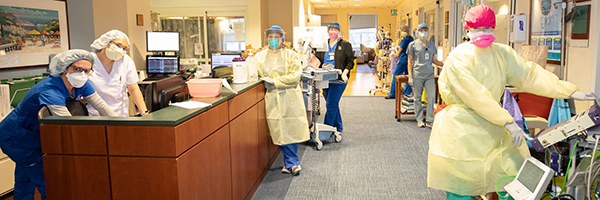EP19EO
Culture of Safety EP19EO
- Provide two nurse-sensitive clinical indicators from the most recent eight consecutive quarters of unit or clinic-level nurse-sensitive, clinical indicator data from the ambulatory setting (e.g., Emergency Department(s), Ambulatory Surgery Center(s) and nurse-run clinic(s)), to demonstrate the outperformance of the mean, median or other measure of central tendency (benchmark provided by the vendor’s national database), or at the highest available level. Data must be the most recent eight, complete quarters available from the vendor(s).
Suggested measures may include, but not limited to:
- Falls with injury
- Ambulatory surgical center (ASC) patient burns
- Adverse outcomes of care: wrong site, side, patient, procedure, implant, or device
- Return to acute care
- HbA1c target levels
- Extravasation rate
- Door-to-balloon time
- Antibiotic stewardship
- Delay in treatment
- Telehealth appropriate disposition
Example 1: Ambulatory Clinical Indicator #1 Percutaneous Coronary Intervention
Early successful Percutaneous Coronary Intervention (PCI) greatly decreases the mortality and morbidity of ST elevation myocardial infarctions (STEMI) and allows earlier hospital discharge and resumption of daily activities. The American Heart Association recommends PCI as the primary reperfusion treatment for patients with STEMI, with the goal of first-medical-contact (door) to device time (balloon) within 90 minutes. At Greenwich Hospital (GH), this indicator is nurse-sensitive as clinical nurses play a critical role in the expedition of the STEMI patient to timely PCI by performing electrocardiograms (ECG), inserting intravenous access devices, obtaining laboratory samples, administering prescribed medications, and transporting the patient to the cardiac catheterization suite.
GH uses PCI within 90 minutes (patients with STEMI) as a performance measure compared to the benchmark provided by the American College of Cardiology Foundation NCDR CathPCI Registry for the population of patients with STEMI. This is calculated as the percentage of PCI STEMI procedures with arrival date/time to first device activation time of ≤ 90 minutes/PCI procedures.
(Evidence EP19EO-1, PCI within 90 Minutes, Patients with STEMI)
Example 2: Chemotherapy Vesicant Extravasation Percent, Ambulatory
Greenwich Hospital’s Bendheim Cancer Center collects and monitors data on chemotherapy vesicant extravasation as part of ongoing quality monitoring. Data are compared to a national benchmark published in 2017, established by a group of 11 National Cancer Institute (NCI)-designated cancer centers. This benchmark was published in Jackson-Rose et al.’s “Chemotherapy Extravasation: Establishing a national benchmark for incidence among cancer centers” as a threshold for all chemotherapy infusion practices to target as best practices. The chemotherapy vesicant extravasation percent is considered a nurse sensitive indicator because ambulatory Bendheim Cancer Center nurses are responsible for administering chemotherapy vesicants and monitoring for adverse effects of administration, such as extravasation.

